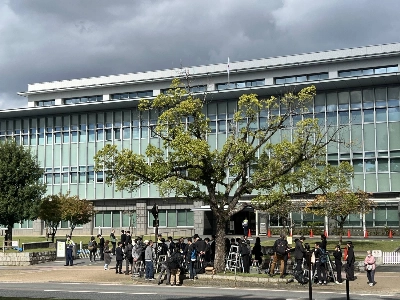Seeing Bertrand Lavier's "Medley" at the top floor Espace Louis Vuitton Tokyo gallery in the early evening, with the twilight glowing through the tinted windows, feels very special. The filtered ambient light fights a losing battle against a brilliant blue and mauve glow from the neon tubes of the piece "Empress of India II" that, as the outside light fades, suffuses the whole space with the color of lavender. On an adjoining wall is the 2014 work "Paysages Aixois" ("Countryside of the Aix-en-Provence"), a tourist road sign that has been painted over with the thick, oversize "Van Gogh" brushstrokes that Lavier has used on a variety of everyday objects and surfaces since the 1980s.
The hybrid painting/object features Mont Sainte-Victoire, an iconic motif in the history of modern painting thanks to Paul Cezanne, and the words "Paysages Aixois." In its normal context the sign would take up a few seconds of your attention at most, as you speed past it on the autoroute (highway). With its irregular hand-painted letters and coating of impasto brush work, Lavier wants us to take more time to ponder this banal civic artifact and consider what happens when an object becomes a painting, or a painting becomes an object. On top of that, the contrast between Vincent Van Gogh's ecstatic self-expression and the painting-by-numbers design language of the French sign is a particularly wry example of the artist's trademark practices of appropriation and surreal juxtaposition.
On the other hand, it's just a repainted road sign. The centerpiece of this small ("bijou" might be the most appropriate word) exhibition is "La Bocca sur Zanker" (2005), a commercially produced version of Salvador Dali's "Mae West Lips Sofa" set atop a household freezer. That's it, literally; but beyond that there are conceptual contrasts of hot and cold, curvy and rigid, flamboyant and utilitarian. Not to mention a whole lot of tongue-in-cheekiness. Lavier seems to relish messing with our cognitive dissonance. As the self-taught artist, who originally studied horticulture, put it in a 2016 interview, "Art is a matter of paradoxes on nearly every level."


















With your current subscription plan you can comment on stories. However, before writing your first comment, please create a display name in the Profile section of your subscriber account page.